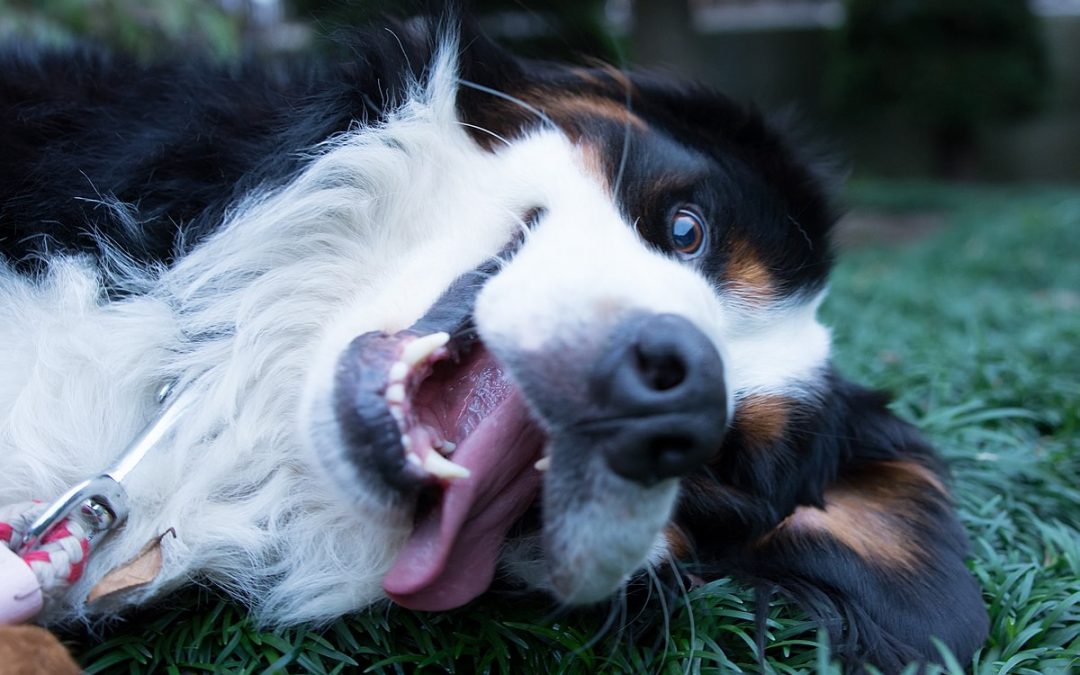
by dbward | Jun 6, 2022 | Facilitation Tips, Misc Awesomeness
This week’s post is by Manya Kapikian and Bill Donaldson
Eyes sparkling, front paws down, stick in mouth, a tail that’s wagging like a helicopter propeller at warp speed. That’s what my dog does when he indicates he’s ready to play. At 7, he’s a mature adult dog with a sense of curiosity, wit, and zest for life.
Associated as a part of childhood, human adults seemed to forget what their animal counterparts have not. Play is an activity that is never to be outgrown. Stuart Brown, author of Play, talks about how play helps children develop as individuals and members of a society. For children, play offers the opportunity to learn and grow, while having a bit of fun along the way. Many adults, on the other hand, are missing out on that benefit.
Brendan Boyle, Founder, IDEO Play Lab wrote: “Work doesn’t have to be serious to be impactful. In fact, we tend to get our best ideas when we break out of the usual routine and have a little fun.”
And so, play became a topic of conversation during a recent Lunch and Learn. The ITK facilitator asked the group: how do you increase play and playfulness during a meeting to increase innovation?
There were many activities that came up during the discussion. Some could be done virtually while others required everyone be in the same room. Here are a few of our activities that were successfully used as captured from the meeting that we’d like to pass along to you:
Rock, Paper, Scissors. If you are looking for an in-person activity, nothing brings out the best of a competitive spirit than Rock, Paper, Scissors. To learn how to play, visit The Official Rules of Rock Paper Scissors. Tip: Whoever loses, becomes the winner’s best friend. By the time you get to the end there’s two people in the room with a fan base behind them. (Warning: This can get loud!)
Group Thumb War. (Yes, this is exactly as it sounds and we can’t wait to try it!). Another in-person group activity. It is based on Jane McGonigal’s book Reality is Broken and to get a sense of what a room full of people thumb wrestling is like, check out the TED video Massive Multiplayer Thumb Wrestling
Animal Sketch Competition. This can be done either in-person or virtual. An excellent energizer, especially before activities like a design studio. It requires a pencil/pen and some paper. A moderator picks out an animal for participants to sketch. There are 3 rounds of sketching the same animal. Each round gets faster and faster – 1 minute, 30 seconds, 10 seconds. The group picks the winning sketch. The artist of the winning sketch gets to pick the animal for the next round.
Music Playlist. This can be done either in-person or virtual. Have a playlist or theme of the day and associate it with music. Play at the beginning as people are coming into the room and close the meeting with a song or two once business is done.
Why were these activities a success?
They were successful because they helped people relax and get into their creative zone. Let’s take the animal sketch competition. Our colleague Jordan uses that often when he starts a design session. He explained,
“You ask them to draw out a cat and it’s amazing how creative people get quickly. By the time they hit round 3, where it’s 10 seconds, people are fired up. They’re laughing. They’re playful. It’s a quick way to get a group in a more fun headspace. It’s a little bit like warming up before exercising right like you’re stretching you know the creative muscles and flexing a little bit and that when you so when you do go into an activity. You are over that hurdle of ‘I can’t sketch anything’ because everybody clearly did 3 rounds of sketching.”
Try it out!
To inject a little bit of play at work requires a little bit of thought and foresight. It could depend on the group, the topic at hand, how much time do you have. An activity can take a few minutes, or even seconds. The examples we gave may take a few minutes. It can also take a few seconds by simply asking everyone picking to pick an emoji or a picture that best describes their mood.
There’s a world of play waiting to be discovered. Below are additional resources. Leave a comment, we’d love to hear about what’s worked for you!
Additional Resources:
Photo credit: Takashi Hososhima
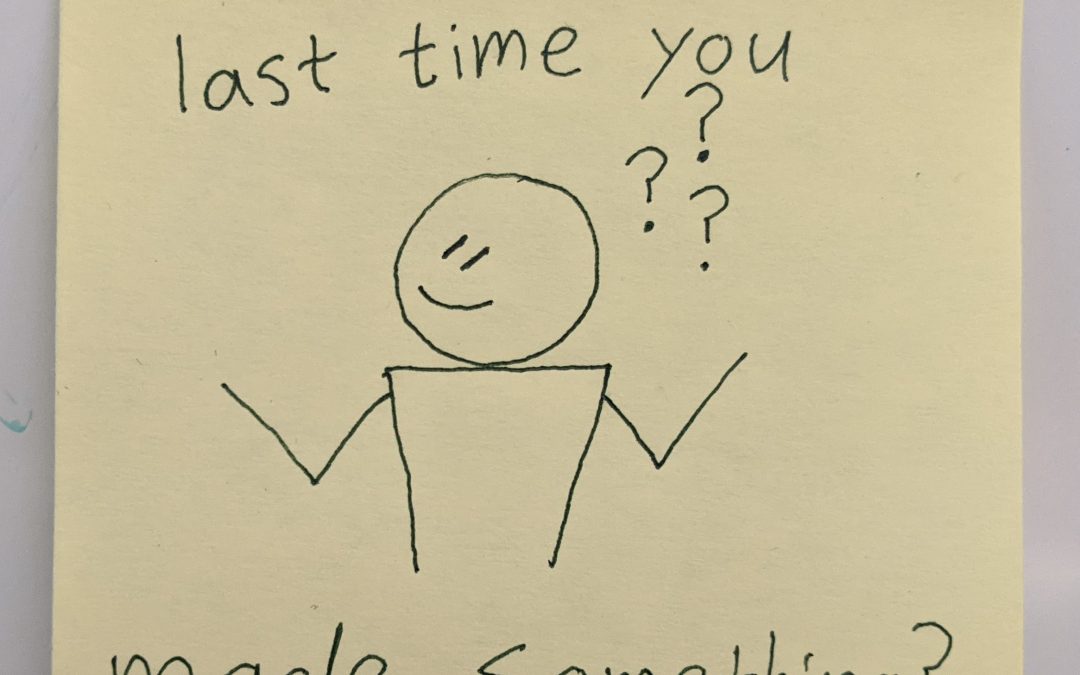
by dbward | May 31, 2022 | Misc Awesomeness
When was the last time you made something? Specifically, when was the last time you made something to share?
I’m not talking about a sandwich or a drink. I’m talking about a creative artifact you can pass along to someone else, so they can use it, learn from it, or be inspired by it.
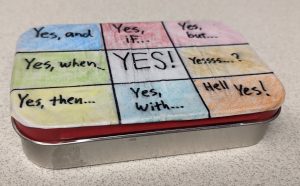
OK, maybe a really good sandwich could fit that bill, but really what I have in mind is a sketch. A photo. A framework. A video. A new tool. A variant on an existing tool (like the X-blossoms or the mini-canvases). Or even an X-blossom decoupaged onto an empty Altoids tin.
We often describe the ITK community as having a “maker culture.” We love to noodle around with prototypes and sketches, building Minimum Viable Products out of cardboard and duct tape. So this post is a friendly reminder and personal invitation to put that cultural attribute into practice. If it’s been a while since you made something, I encourage you to make it a priority… to make something today.
Not sure how or where to get started? Click on a few of the links in this blog post and see what sort of creative ideas jump out at you. And if time is short, then set a timer for 5 or 10 minutes, and see what you can make before the buzzer goes off. You just might be surprised!
And of course, don’t forget to share the results of your creative efforts with someone.
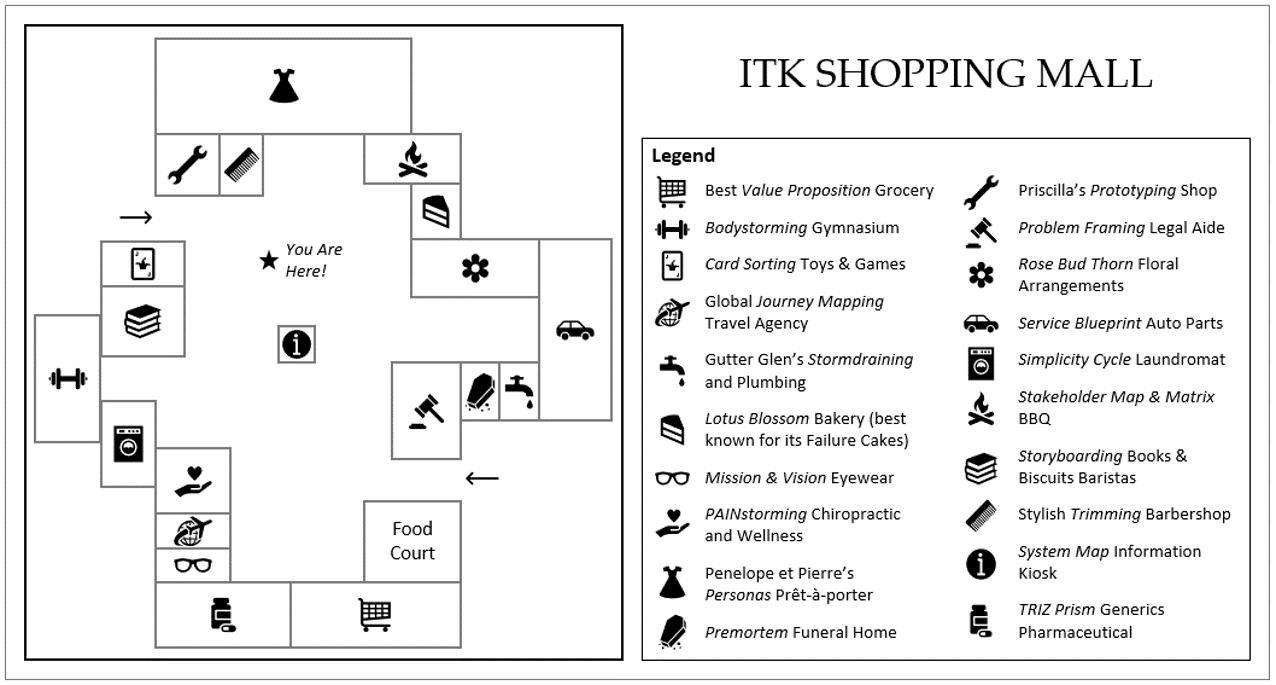
by dbward | Mar 28, 2022 | Misc Awesomeness, Success Stories |
This week’s post is by guest blogger Allison Khaw!
A few weeks ago, on my own time, I dove into a short-term creative project.
I was inspired by Karim Thompson on the Innovation Toolkit team: he invented a list of fictional strip mall business names based on some of the ITK tools. Functionally, the list helped you remember the tool names, but its intangible benefits went well beyond that. I remember how so many of us on the team were not only entertained but also energized by what he created. At some point, I concluded—this can’t be forgotten in the annals of team history!
Adapting Karim’s list into a more visual format seemed like a natural next step. I expanded the original list by adding a few business names of my own, and then I formed a map legend and designed a map layout. Several versions later, the final “ITK Shopping Mall Map” was born! It was quite an iterative process, and looking back, I asked myself:
What takeaways do I want to share as a result of this experience?
- Don’t limit yourself to a certain approach just because that’s how it’s been done before.
From the start, I planned to include this shopping mall map in our ITK Handbook, which is an ITK how-to guide and an informal sequel to our choose-your-own-adventure-style book The Toolbox of Innovation. Since I made line drawings by hand for our first book to resemble the CYOA books of the 80’s and 90’s, I originally planned to draw the map by hand as well. However, I realized that the non-CYOA style of the ITK Handbook opened up other possibilities. In fact, only after letting go of the “It’s always been done this way before!” argument did it become clear to me that electronically creating the map was the better option to begin with.
- Set yourself up for exploring new ideas by periodically saving backup versions.
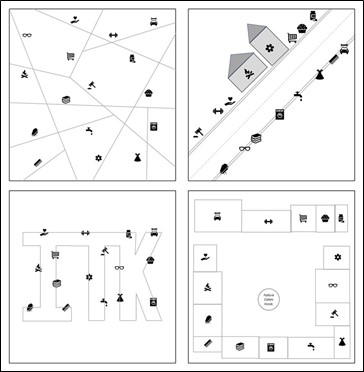
I decided to keep it simple by using PowerPoint as my creation software. As I developed the map, I got into the habit of duplicating my in-progress version and then working off of the newer copy, which resulted in dozens of sequential PowerPoint slides. Although this was a basic technique (thank you, copy and paste!), it made all the difference. It allowed me to incrementally move forward with new ideas in the design process—and if I liked an old idea better, I could always find my way back. To illustrate this, see the provided figure with four map versions at different points in the brainstorming process. Some versions were considerably better than others!
- To leave yourself room for inspiration, set minimal expectations and build flexibility around deadlines.
Given the nature of this side project, no one would have been upset if I didn’t finish it. In many ways, this was incredibly freeing. I was self-motivated to see my vision come to fruition, but I took my time looking into common shopping mall layouts and actually discovered one of my best design ideas after a leisurely session of experimentation. Even for projects with fixed deadlines, starting early to give yourself flexibility can be invaluable. Yes, sometimes constraints are useful, but other times the feeling of not being rushed can be exactly what you need to achieve results.
- The end result may seem obvious in hindsight, but the path it takes to get there is often quite the opposite.
A final product that looks simple and effortless usually belies the very effort that you put into it. What’s more, this is a good thing—it means that your hard work has paid off! I have experienced this before when using the Premortem and Mission & Vision Tool, and I found this to be true here too after following a winding path to reach the final design of the map. Blaise Pascal summarized it nicely back in the seventeenth century, when he is said to have penned, “I would have written a shorter letter, but I didn’t have the time.” We need to more consistently give ourselves the opportunity to go that extra mile—and write that shorter letter.
This side project was fulfilling in that it allowed me to breathe new life into the fictional ITK business names that Karim created. Not only did I learn valuable lessons from the iterative nature of the map design process, but each time I look back at the completed ITK Shopping Mall Map, I can’t help but grin at everything it represents.
More than anything, I consider that a measure of success if ever there was one. Best of luck on your own creative pursuits!
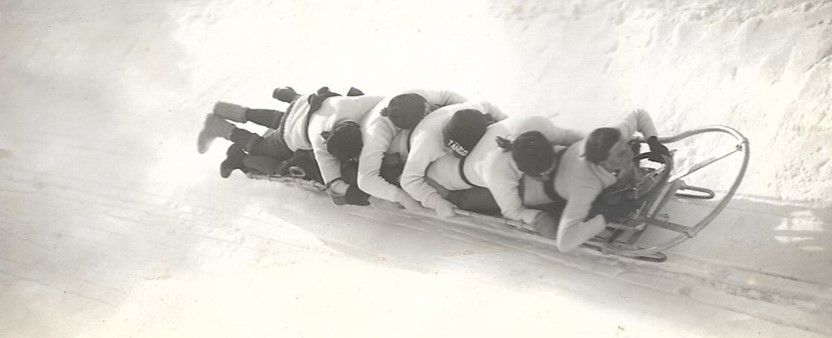
by dbward | Feb 21, 2022 | Misc Awesomeness
As the 2022 Winter Olympics come to a close, I find myself thinking about the concept of being “the best.” In Olympic competitions of course, each event awards a gold medal to a competitor who comes out ahead in a rigorous competition. They are The Best.
In some events, the difference between gold and a non-medal fourth place is measured in fractions of a second. I even saw situations where an athlete’s performance broke the previous world record, but they still came in fourth because three other people were oh-so-slightly faster. Clearly, the gold medalists aren’t the only ones doing excellent work. In other events, the difference between first and fourth is more pronounced. For example, Italy’s mixed doubles curling team had a perfect 11-0 record in the round-robin tournament, and they played nearly flawless matches, absolutely dominating the field. In the fourth end of their match against Norway… but I digress.
The point is, this whole thing got me thinking about one of my favorite questions: Who are the top performers in YOUR field?
In any field or discipline, some people will simply do the work better than most. Take a moment to think about what you do – can you name the people who set the bar in your particular field? Who are the leading voices, the practitioners who deliver outstanding results, the ones who would wear gold medals if such things were awarded? Keep in mind that the list of top performers will change over time. Nobody stays in the winner’s circle forever and even Shaun White came in fourth in the half-pipe competition this year. So this is a good question to ask on a regular basis as new players enter the stage and surpass previous records. Once you’ve got a list of top people in your field, you may want to ask a few additional questions:
- What makes them a top performer?
- What do they do differently?
- What can we learn from them?
- Could we reach out to them?
- Partner with them?
As I watched the Olympics this year, I was struck by how often the commentators described the relationships between competitors. They all knew each other and learned from each other. They competed against each other many times before arriving at the Olympics. They made each other better. I think there is a lesson there for all of us.
Image Credit: The 1913 Saint-Moritz Bobsleigh Derby Cup by Albert Ewald
by dbward | Aug 9, 2021 | Keeping up with the team, Misc Awesomeness
This week’s post is by Tracey Amos
In early May, MITRE’s Health Leadership Development team partnered with the Innovation Toolkit (ITK) team to deliver a weeklong Innovation Toolkit training series focused on hands-on use of several of the most popular Innovation Toolkit tools – Lotus Blossom, Mission and Vision Canvas, Problem Framing and Premortem.[1]
The series kicked-off with two 1-hour ITK overview sessions. The overview sessions drew over 200 participants and based on feedback, provided a valuable introduction and insights into how to use the Innovation Toolkit tools. In the words of one participant: “I had only heard about the ITK but didn’t really understand what it was. The session was a great introduction to the set of tools.”
The kick-off event was followed by five days of tool specific training. Two of the sessions were structured around use cases for current MITRE projects.
One session focused on the Premortem tool training: Project Leader Iris Sherman partnered with ITK facilitators Gabby Raymond and Jonathan Rotner to build a use case exploring possible impacts of not implementing a MITRE program recommendation in its final report. Using the Premortem tool, the training session framed and explored a worst-case scenario and used the input to define an updated goal and risk mitigation strategy. In the words of one participant: “Instead of waiting until the end of a project to find out what went wrong, and learn for the future, we can use this technique to go on an “imaginary time travel” to avert real failures.”
The other session focused on the Problem Framing Tool: Project Leader Audrey Winston partnered with ITK facilitators Tracey Amos and Tammy Freeman to build a use case to examine how Robotic Process Automation (RPA) and Artificial Intelligence (AI) might be applied to increase the ability of Medicare website visitors to complete routine tasks or search information without costly human intervention and to understand how other organizations serving similar populations (e.g., senior citizens, disabled, caregivers) use RPA and AI. The training session provided an opportunity for the MITRE project team to engage in a collaborative conversation with others, broadening their perspective around areas where automating processes using RPA and AI could potentially be a “game changer.” The team is confident that a compelling case can be made for further exploration in this opportunity space.
The Innovation Toolkit Training week ended with a “Meet the Authors” Roundtable event where members of Team Toolkit engaged attendees in discussion about the inspirational journey to curate the ITK suite of tools and to discuss their recently published book, The Toolbox of Innovation, a lively, playful gamebook written in a’ choose your own adventure’ style.
The Innovation Toolkit Training week was part of a suite of FY21 leadership development and training opportunities sponsored by Health FFRDC leadership as part of their commitment to “building trusted and innovative leaders.”
Throughout the course of the week, participants expressed interest in learning more about the ITK tools and how to apply them to engage their teams and their sponsors. In response, several Health FFRDC “pop-up” ITK events are being planned for later this summer! Stay tuned.
Has your project also used the ITK? Please comment and share your story!

by ITK Administrator | Mar 8, 2021 | Keeping up with the team, Misc Awesomeness
Today’s post is by Allison Khaw!
Can a diverse group of seven engineers and designers write a book? Can they write a book about innovation, teamwork, and problem solving, in a collaborative fashion, while working in a virtual environment?
The answer is yes.
In fact, that’s exactly what seven of us on the MITRE Innovation Toolkit team did this past year! Fresh off the press, our book is called The Toolbox of Innovation, and we—Jen Choi, myself (Allison Khaw), Gabby Raymond, Dan Ward, Kaylee White, Niall White, and Jessica Yu—couldn’t be more excited to share it with the world.
As the first line of the book says, it was an experiment. We didn’t know how our book would turn out, or if it would turn out. There was only one way to know the answer, and that was to sit down and start putting words on the page.
We used a writing style similar to the “Choose Your Own Adventure” books that were popular in the eighties and nineties, except that we placed our characters in a real-world setting. You—the reader—are the protagonist of the story, which revolves around a passionate team applying innovation methods to develop a product that will delight its users. Depending on the path you take through the book, you’ll learn about intrapreneurism, self-advocacy, problem framing, prototyping, failure, and more. If you encounter a dead-end in your current path, simply turn around and make a different choice.
 Throughout the writing process, we focused on ways to be more collaborative and creative. We took on the scenes we were most passionate about, learning firsthand that messy first drafts are inevitable. We edited each other’s scenes without feeling like we needed permission. As our book took shape, we incrementally built our cast of characters and mapped out the myriad plot threads. We also learned about self-publishing and the effectiveness of fiction in teaching real-world lessons. Ultimately, it was an exercise in shared leadership as well as a refreshing opportunity to embrace risks.
Throughout the writing process, we focused on ways to be more collaborative and creative. We took on the scenes we were most passionate about, learning firsthand that messy first drafts are inevitable. We edited each other’s scenes without feeling like we needed permission. As our book took shape, we incrementally built our cast of characters and mapped out the myriad plot threads. We also learned about self-publishing and the effectiveness of fiction in teaching real-world lessons. Ultimately, it was an exercise in shared leadership as well as a refreshing opportunity to embrace risks.
It was an incredibly rewarding experience, in more ways than one.
One of my favorite parts of our book is its playful nature. You’ll find scenes involving Bigfoot, failure cake, juggling, and alternate endings, not to mention a suspiciously large number of potato chip references. (You’d think we were sponsored by a snack food company—nope, our characters just really like chips!) Each of the co-authors brought a different perspective to the table, and we’ll be finding ways to share our experiences and lessons learned, starting with this blog post. We want to help you perform your own experiments, in all their glory.
Now, what are you waiting for?
If you want to find out more, go to The Toolbox of Innovation
If you are undecided, mull it over and then re-read the previous line
When you’re ready, turn to the first page of the book, and take the story where you will. It’s your adventure, after all—you get to call the shots.








 Throughout the writing process, we focused on ways to be more collaborative and creative. We took on the scenes we were most passionate about, learning firsthand that
Throughout the writing process, we focused on ways to be more collaborative and creative. We took on the scenes we were most passionate about, learning firsthand that